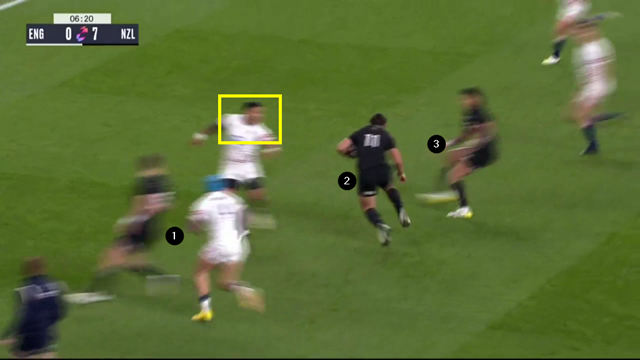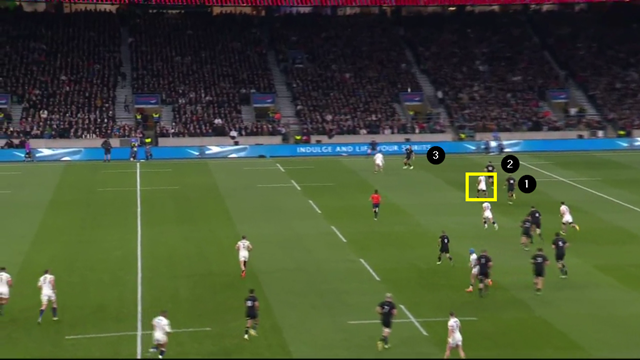Tales abound of how important the Australian Institute of Sport was to the development of Rugby Union in the country. The National Coaching Director between 1974 and 1995, Dick Marks, only had to walk down the corridor from his office to compare notes with his peers in League or Aussie Rules and spark new ideas. The crossover of information was immediate, and it coincided with the two most successful decades in Australian rugby history between 1980 and the turn of the millennium.
The addition of ‘The Professor’ Wayne Smith and Sir Graham Henry to the Wahine Toa coaching team was key to the recent success of the Black Ferns at the Women’s World Cup, and their impact has sent ripples out far beyond their remit, and into the men’s game.
In the early stages of the Women’s World Cup, I wrote the following article about the Ferns’ ability to convert vertical attacks up the middle into horizontal assaults out wide https://www.therugbysite.com/blog/attack/the-absolute-clarity-about-the-where-and-how-of-the-attack , principally by means of the cross-kick to the far wing.
The men’s encounter between New Zealand and England at Twickenham illustrated how much of this I.P has already crossed over into the All Blacks. Wayne Smith and Graham Henry had made a point of acquiring talent from the Sevens program, and the likes of Sarah Hirini, Portia Woodman, Stacey Fluhler, Ruby Tui and Theresa Fitzpatrick would all rank among the Wahine Toa’s most important contributors at the World Cup.
The current All Blacks back-line contains five starters who have all played in the back three, at full-back or wing: Jordie Barrett (full-back), Rieko Ioane (wing), Mark Telea (wing), Caleb Clarke (wing) and Beauden Barrett (full-back). The common factor between the sexes is that players from Sevens, and those who have spent a lot of time in the back three, all tend to do their best attacking work in space. The quickest way to get them the ball is via the cross-kick to the far wing.
New Zealand had already mooted their intentions in the previous match versus Scotland:
Jordie Barrett cross-kicks for Telea to score in Murrayfield’s deep in-goal area. What was a trickle in Edinburgh became a torrent in West London, with the All Blacks launching no less than six cross-kicks between the first and 50th minutes of the game.
Let’s take a look at some of the nuances which made their strategy so effective. The first example came from a scrum:

There are a number of factors which make the cross-kick attractive to New Zealand in this scenario. Firstly, because the play is made from midfield, the England full-back (Freddie Steward) is in the backfield and unable to help out his wing (Jack Nowell in the blue hat). Secondly, the All Black had also worked out that Nowell’s help from the inside would be coming from Manu Tuilagi, a powerful frontal defender who is less adept at moving to cover the width of the field.
If Caleb Clarke makes the catch, New Zealand can put more speed around him – “1” Jordie Barrett and “2” Rieko Ioane – than England can muster on defence. Play moves deep into the England 22 before number 12 Owen Farrell is able to get back and make a tackle.
With so much back three talent on the field at the same time, it was also easy for New Zealand to launch the cross-kick with different personnel:
In this case, it is Beaudy kicking across for his brother Jordie to get first touch over the beleaguered Nowell out on the left. What worked from right-to-left, worked just as well going in the opposite direction:

The screenshot clearly illustrates New Zealand’s intentions – to get the ball to the receiver (Ioane) with his support (Jordie and Telea) already ahead of Tuilagi in the race from the inside. Once the catch has been made and they are playing in space, the trio know they can draw Tuilagi and create the breaking opportunity. By the end of the play, Rieko Ioane had reloaded to become the potential finisher, and there is no faster player in a straight line than he.
The All Black duly received the reward for their clear thinking in the 50th minute of the second period:
It all looks so very simple. With Steward again starting out of shot and having to divide his attention in backfield duty, all Clarke has to do is catch the ball and deliver a pass to Ioane, in the sure knowledge that Tuilagi will never be able to make up ground and complete the tackle on the Blues’ flyer. It is simple but beautiful in conception.
Summary
Deliberately or not, there was a transmission of essential I.P from ‘the Professor’ of the Black Ferns at the World Cup to the All Blacks at Twickenham. Both coaching groups arrived at the understanding that with a full crew of Sevens or back three specialists at your disposal, the best attacking idea was to get the ball to them early and in space, and do it as directly as possible via the cross-kick. Field position, and the natural tendencies of England’s ‘reading’ defender at number 13 only hastened the process to its conclusion.












.jpg)

.jpg)







